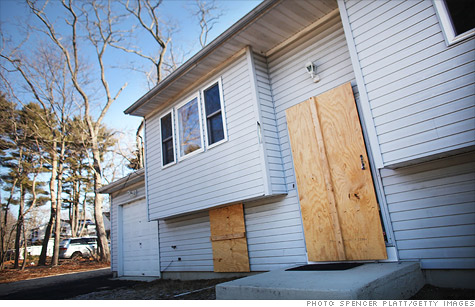
A TARP program that aims to help the nation's most struggling homeowners is falling short, said a special inspector general for the bailout program.
WASHINGTON (CNNMoney) -- A federal-state program aimed at helping homeowners in states hardest hit by the mortgage crisis is falling far short of its goals, a federal watchdog said in a report released Thursday.
In the report, the Special Inspector General for the Troubled Asset Relief Program (TARP) said that just 3% of $7.6 billion available in the Hardest Hit Housing Markets program -- available for 18 states and the District of Columbia -- had been tapped as of Dec. 31.
The money has gone to help 30,640 homeowners, or about 7% of the 458,000 homeowners officials estimated would be helped by the end of the program in 2017, according to the watchdog.
More than 75% of the program funds has gone to prop up state unemployment programs that pay mortgages of the unemployed -- not efforts such as mortgage modifications or principal reductions that would force banks to take a hit, according to the report.
Christy Romero, the Special Inspector General for the Troubled Asset Relief Program, said the hardest hit fund has largely served to help the unemployed.
"It was supposed to be an innovative program intended to reach the unemployed and underwater homes," Romero said in an interview with CNNMoney. "It is important to reach the unemployed, but it's not reaching underwater homes like it was intended."
Treasury defended the hardest hit program. The program gives states the opportunity to "leverage their unique understanding of the conditions in their communities to create effective, locally tailored programs," Assistant Secretary for Financial Stability Timothy Massad said in a letter to Romero.
TARP is the $700 billion bailout program that Congress passed at the height of the financial crisis in the fall of 2008. In addition to keeping the big banks afloat, TARP gave money to programs to help struggling homeowners.
Other larger TARP-funded housing programs, including the Home Affordable Modification Program, have weathered criticism, especially from the special inspector general, for falling short in its goal of easing the national foreclosure crisis.
This new watchdog report focused on a different, smaller program, the Hardest Hit Housing Markets program. The hardest hit program was targeted to states with the largest numbers of homeowners drowning in negative equity and unemployment.
The money was supposed to give state housing officials incentives to come up with new and different ways to address the housing crisis in their states. But most states just used the money for programs that pay the mortgages, insurance and property taxes of the unemployed.
So far, the hardest hit program has kept up with mortgage payments for some 26,100 unemployed homeowners. These programs don't hit mortgage servicers or banks' bottom lines, Romero said.
When it comes to relieving housing woes, so far, only 436 homeowners in the program got the principal owed on their mortgage reduced. Another 170 homeowners got their second lien reduced.
A big problem, which the federal government faced with all its housing programs, was getting servicers on board, according to the watchdog. The states have far less leverage than the federal government in getting servicers to work with them on programs.
Treasury also took eight months to get the federal government-backed guarantors Freddie Mac and Fannie Mae to support the program, according to the SIGTARP report.
"Treasury failed to recognize the lack of bargaining power that states had for recruiting servicers," the report said.
Treasury's Massad disagreed with SIGTARP's conclusion, saying Treasury "actively and consistently engaged with servicers" and the government-backed housing guarantors in the earliest stage of the program.
Rep. Darrell Issa, a California Republican, asked the watchdog to review the hardest hit program. ![]()
| Overnight Avg Rate | Latest | Change | Last Week |
|---|---|---|---|
| 30 yr fixed | 3.80% | 3.88% | |
| 15 yr fixed | 3.20% | 3.23% | |
| 5/1 ARM | 3.84% | 3.88% | |
| 30 yr refi | 3.82% | 3.93% | |
| 15 yr refi | 3.20% | 3.23% |
Today's featured rates:
| Latest Report | Next Update |
|---|---|
| Home prices | Aug 28 |
| Consumer confidence | Aug 28 |
| GDP | Aug 29 |
| Manufacturing (ISM) | Sept 4 |
| Jobs | Sept 7 |
| Inflation (CPI) | Sept 14 |
| Retail sales | Sept 14 |